Home is where the heart is… and so much more. It is a place where we can enjoy a quality life with our loved ones, and a foundation on which our dreams can be built and fulfilled.
Beyond providing comfortable housing, our HDB neighbourhoods are designed with features that enable accessibility for everyone, and communal spaces to foster neighbourliness. Volunteers have also come forward to provide care for the needy and our environment.
Our lush landscape is an important aspect of our living environment and great effort has been put in place to conserve our natural heritage while creating a City in a Garden.
Hardware for Heartware
Hardware for Heartware
HDB fosters a sense of neighbourliness and community by designing and constructing different community spaces that promote interaction.
Vibrant Communities
Vibrant communities that reflect a common "Singaporean identity" are built through daily interactions and an appreciation of our nation’s diverse ethnicity, culture and history. These vibrant communities did not come about by chance, but through the careful planning of spaces and programmes for neighbourly interaction.
Quota System
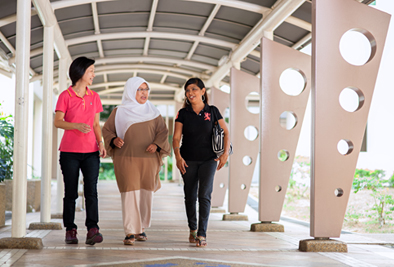 The Ethnic Integration Policy (EIP) is implemented to promote racial integration and harmony. The policy also aims to prevent the formation of racial enclaves by ensuring a balanced ethnic mix among the various ethnic communities living in public housing estates.
The Ethnic Integration Policy (EIP) is implemented to promote racial integration and harmony. The policy also aims to prevent the formation of racial enclaves by ensuring a balanced ethnic mix among the various ethnic communities living in public housing estates.
In addition to the EIP, the Singapore Permanent Resident (SPR) quota is also introduced to ensure that SPR families can better integrate into the local community for social cohesion.
Void Decks
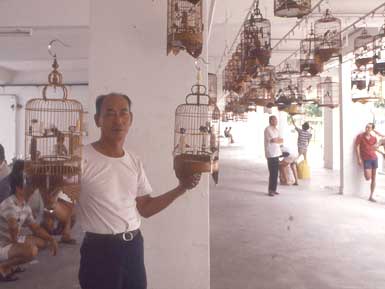 Void decks are venues for social and recreational activities. They build community ties and promote racial integration by presenting ample opportunities for Singaporeans of different backgrounds, age groups and races to meet and interact.
Void decks are venues for social and recreational activities. They build community ties and promote racial integration by presenting ample opportunities for Singaporeans of different backgrounds, age groups and races to meet and interact.
Common Corridors
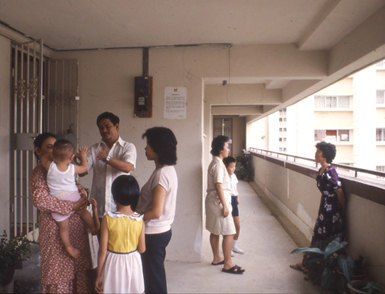 Common corridors are designed to be convergent points for residents to meet and mingle, promoting neighbourliness and a sense of community.
Common corridors are designed to be convergent points for residents to meet and mingle, promoting neighbourliness and a sense of community.
Evolution of Playgrounds
Evolution of Our Playgrounds
Singapore's playgrounds have evolved over the years, reflecting our nation's transformation and changing family dynamics, as well as catering to the needs of different generations of citizens.
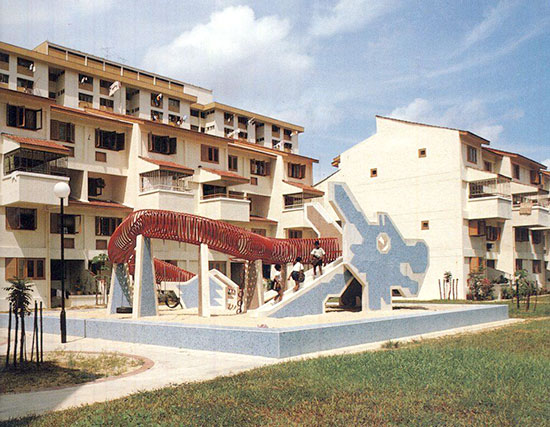
70s - 80s: Functional Play Equipment
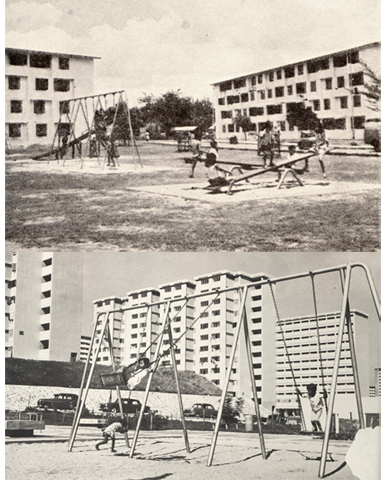 Before the early 70s, playgrounds in older estates generally comprised basic play equipment such as slides, swings and see-saws.
Before the early 70s, playgrounds in older estates generally comprised basic play equipment such as slides, swings and see-saws.
Between the mid-70s and early 80s, more elaborate and interesting playgrounds with distinctive forms such as dragons, elephants and bullock carts were introduced.
Mid-80s: Themed Playgrounds
 In the mid-80s, HDB introduced many playgrounds with themes inspired by nursery rhymes, children's games, daily experiences and our multicultural heritage.
In the mid-80s, HDB introduced many playgrounds with themes inspired by nursery rhymes, children's games, daily experiences and our multicultural heritage.
These playground designs included Humpty Dumpty, Shoe House, Fire Engine, Clock, Chinese Bumboat, Kelong and many more.
Late-80s: Distinctive Designs
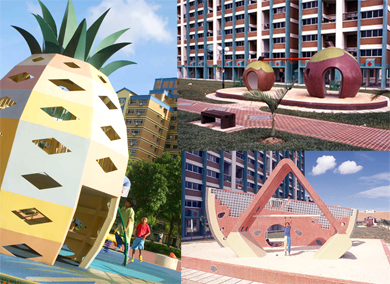 In the late 80s, playgrounds depicting local fruits and vegetables (mangosteens, water melons, pineapples, etc), insects and other familiar objects were introduced.
In the late 80s, playgrounds depicting local fruits and vegetables (mangosteens, water melons, pineapples, etc), insects and other familiar objects were introduced.
90s: Proprietary Play Equipment
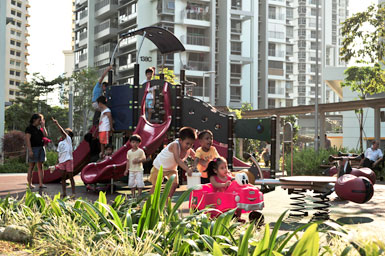 Introduced into our neighbourhood parks and later into the precincts in the 1990s, the new play equipment was structured to encourage greater interaction between children and their families
Introduced into our neighbourhood parks and later into the precincts in the 1990s, the new play equipment was structured to encourage greater interaction between children and their families
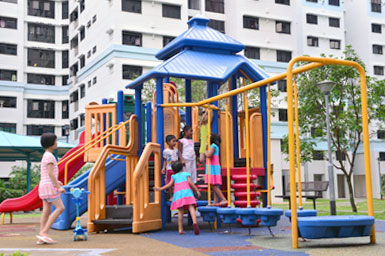
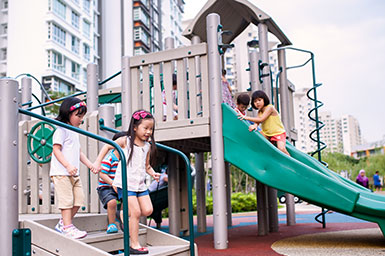
2000s: Family Playground
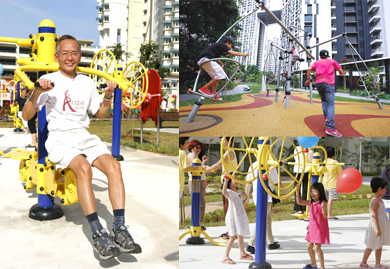 Family playgrounds or 3-Generation (3G) fitness corners are a holistic alternative to the metal and concrete sandpit playgrounds that served as a source of entertainment for children in the eighties and nineties. Modern and purposefully designed, these 3G fitness corners consist of a playground for children and separate exercise areas and equipment for adults and seniors, allowing three generations to come together.
Family playgrounds or 3-Generation (3G) fitness corners are a holistic alternative to the metal and concrete sandpit playgrounds that served as a source of entertainment for children in the eighties and nineties. Modern and purposefully designed, these 3G fitness corners consist of a playground for children and separate exercise areas and equipment for adults and seniors, allowing three generations to come together.
The 3G fitness corners are located in the heart of a precinct, catering to residents who live in the surrounding HDB blocks. These fitness corners also serve as a point of congregation for residents.
Living in a Garden
Living in a Garden
Singapore embarked on a greening journey to enhance the quality of living for the people, and make our island-state distinctive and attractive.
As Singapore evolves from Garden City into a City in a Garden— "a bustling metropolis nestled in a lush mantle of tropical greenery" – our greenery plan has also entered a new phase of development. More innovative and sophisticated greening strategies have been adopted to add new dimensions to green spaces, and heritage and biodiversity preservation and community involvement objectives have also been highlighted.
Six key areas have been identified by NParks to guide efforts towards fulfilling our City in a Garden vision:
- Engaging and inspiring communities to co-create a greener Singapore
More than 850 community gardens have been added to make our towns and cityscape greener, thanks to a self-motivated network of residents, schools and organisations volunteering time and effort.
- Enhancing competencies of our landscape and horticulture industry
Centre for Urban Greenery and Ecology, a national training institution for the landscape industry, has been set up to raise skills standards and industry productivity and research new solutions in urban greening and conservation.
- Enriching biodiversity in our urban environment
On top of ensuring the health of key species and ecosystems, restoring our natural areas and enhancing our country's nature reserves, extending biodiversity further into the urban landscape will also enrich our urban living.
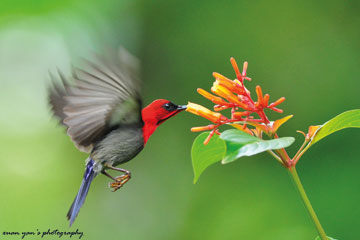
Crimson sunbird harvesting food.
Photo credit: Han Xuan Yan
- Establishing world-class gardens
The Singapore Botanic Gardens and Gardens by the Bay have earned premier world-class reputations, showcasing the best in horticulture and garden artistry and capturing the imagination of the world.
- Optimising urban spaces for greenery and recreation
Thematic greenways linking major parks, nature sites and housing estates, high-rise gardens, even spaces below MRT tracks could all be optimised for introducing and enhancing greenery.
- Rejuvenating urban parks and enlivening streetscape
By developing streetscape gardens and introducing more flowering species, our streetscape will become even more vibrant, and our urban parks will be more attractive as leisure destinations where Singaporeans can all come together to play, celebrate and connect.
Greening has been an integral part of Singapore's development since the 1960s.
Biodiversity and greenery play crucial roles in providing ecosystem services, improving human health and well-being, and securing the quality of life for city dwellers.
Greening of Housing Estates
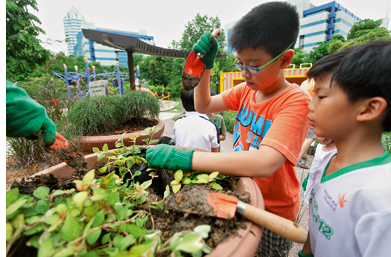 Skyrise Greenery
Skyrise Greenery
Flourishing greenery on rooftops and facades give a touch of nature and visual relief to crowded estates. Today, there are more than 65ha of skyrise greenery.
Community Gardens
There are more than 850 community gardens with over 20,000 community gardeners involved.
Greening of the City
Park Connector Network (PCN)
Park Connector Networks serve as "green corridors" that provide Singaporeans with additional recreational options and connect parks together.
Gardens by the Bay
Gardens by the Bay is a first-of-its-kind tropical garden that pushes the boundaries of how plant life can be presented in an urban environment for public enjoyment.
Fusing nature, architecture and technology in a sustainable way, the Gardens' cooled conservatories enable a whole new world of plants to be grown in Singapore while its Supertrees take skyrise greenery to new heights.
Preserving Our Natural Heritage
Sungei Buloh Wetland Reserve
With an extensive mangrove forest and rich biodiversity, Sungei Buloh Wetland Reserve is Singapore's first ASEAN Heritage Park and an important stop-over for migratory birds.
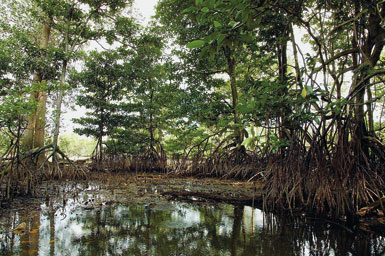
Mangroves at SBWR
Photo Credit: Jeremy Ang
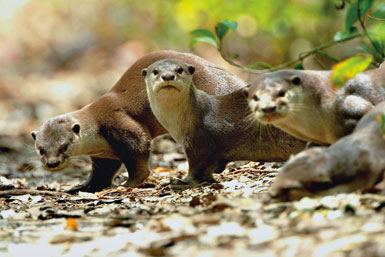
Smooth Otter found at SBWR
Bukit Timah Nature Reserve
Bukit Timah Nature Reserve has one of the largest patches of primary rainforest left in Singapore, as well as the tallest hill. The reserve is home to 40% of our nation's flora and fauna.
Singapore Botanic Gardens
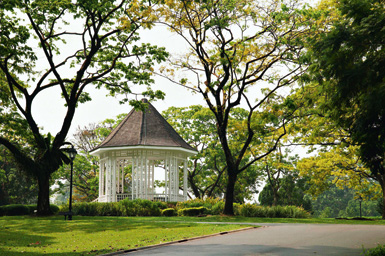
Singapore Botanic Gardens Bandstand
Photo credit: Chew Bee See
Singapore's first UNESCO World Heritage Site. The Gardens is the first in Asia and the only tropical botanical gardens on the list.
Labrador Nature Reserve
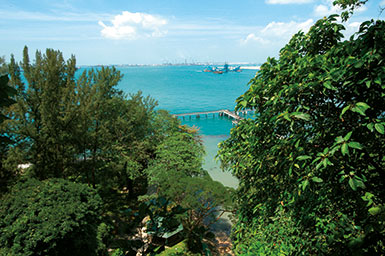 Labrador Nature Reserve is home to the only rocky shore on mainland Singapore. Its coastal cliffs covered in secondary vegetation shelter a wide variety of birdlife. The reserve is also rich in history, with fierce battles fought here in World War II.
Labrador Nature Reserve is home to the only rocky shore on mainland Singapore. Its coastal cliffs covered in secondary vegetation shelter a wide variety of birdlife. The reserve is also rich in history, with fierce battles fought here in World War II.
Pulau Ubin
Pulau Ubin is one of Singapore's last rural areas. At Chek Jawa Wetlands, six major habitats converge, making it one of the best places in Singapore to observe and study a variety of marine and terrestrial animals.
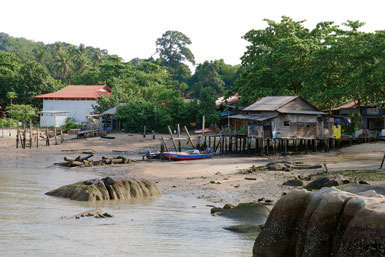
Pulau Ubin, view from jetty
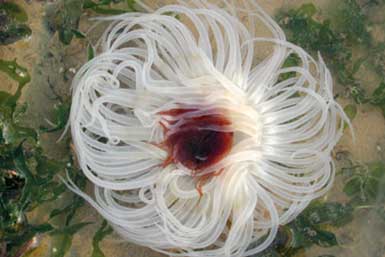
Peacock Anemone
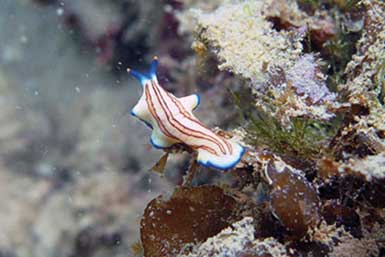
Flatworm (Pseudoceros sp.)
Visit NParks' Website to find out more
Universal Design
A City for All Ages
Our built environment needs to evolve with our changing demographics in order to maintain quality of life for citizens of all ages.
With a growing population and ageing demographic, accessibility is an increasingly important aspect of our built environment. In shaping a living environment that is more friendly to the elderly and the physically challenged, Singapore is also taking on a broader perspective of creating an inclusive City for All Ages. This requires an appreciation of the diversity of needs and adopting a Universal Design approach towards designing buildings and spaces that can be used and enjoyed by people of different abilities and ages.
The Code on Accessibility was introduced in 1990 to provide minimum standards on barrier-free accessibility and guidelines to help developers and architects in planning and designing for barrier-free accessibility in their developments. Over the years, the Code has progressively included more elder-friendly and family-friendly provisions to move with the times and promote an inclusive society and a future-ready built environment.
To encourage building owners to move beyond mere compliance and towards incorporating Universal Design in their buildings, BCA introduced the Universal Design Mark Certification Scheme in 2012 to give recognition to developments that incorporate thoughtful Universal Design features in their projects. The scheme has helped to achieve greater buy-in from the built environment sector and raise public awareness towards user-friendly buildings.
Today, the built environment is more seamlessly connected and accessible not only to wheelchair users, but also the elderly, families with children and people with other disabilities. Here is an interview with Mr Edmund Wan, President of the Handicaps Welfare Association.
“The most important benefit that Universal Design brings to the PWDs is public awareness of the needs of these people and acceptance in communities.”— Mr Edmund Wan, President of Handicaps Welfare Association
- What are some of the day to day problems that Persons with Disabilities (PWDs) face that the public might not be aware of?
The problems faced by PWDs are not unique and depend on their level of disabilities. Most of us take for granted or do not perceive them as a problem. PWDs face various kinds of problems or challenges such as:
- Accessibility and safety in the built environment;
- Accessibility in transport;
- Accessibility of public facilities and information;
- Accessibility of toilets and eateries;
- Coping with the fast pace of life;
- Availability of multi-dimensional jobs;
- Lack of availability of low skills jobs suitable for people with disabilities as Singapore advances to more service and knowledge based economy;
- People tend to view a disabled person with sympathy and not look at their abilities and qualifications; and
- Simple daily living skills – e.g. brushing their teeth.
- How has Universal Design enabled PWDs to overcome these obstacles?
The Universal Design helps PWDs overcome the challenges they face in the built environment by providing:
- Ramps instead of steps;
- Large signages with audio;
- Wider and better facilities to aid mobility;
- Special and wider parking lots for ease of embarkment or disembarkment from vehicles; and
- Accessibility includes information and not just the built environment.
Buildings built before 1996 are gradually going through retrofitting in stages to accommodate the needs of the people with disabilities and the elderly.
- What are the barriers and obstacles faced in ensuring accessibility for PWDs so far? How were they overcome?
Some of the barriers faced in ensuring accessibility for PWDs include:
- Space constraints. The mall is accessible but not the shops within;
- Increased cost of development affects the selling price;
- Many developers don’t see the need to devote so much useable and selling space to accommodate accessibility; and
- Inconvenience of retrofitting existing structures.
However, most of these problems have been overcome with rules and benefit approaches such as:
- Requirements in BCA’s Code on Accessibility; and
- BCA’s Accessibility Fund which provides funding incentive to building owners to implement accessibility features.
- Could you name some of the significant benefits Universal Design brings to PWDs?
Universal Design opens up many opportunities and facilities to PWDs.
The most important benefit that Universal Design brings to the PWDs is public awareness of the needs of these people and acceptance in communities.
People with severe disabilities and the elderly, who previously used to be home bound due to inconvenience, are able to come out of their home and enjoy the public and tourist facilities.
However, the true benefit of Universal Design is integration and not segregation.
- What are some of the 5 most common and beneficial Universal Design features for PWDs?
- Equal access and opportunities;
- Accessibility of HDB blocks;
- Accessibility of public toilets;
- Accessibility of transport; and
- Accessibility of work places, schools, recreational places, etc.
- The accessibility of buildings to the handicapped has increased since the code on Barrier-Free Accessibility in Buildings in 1990. In your opinion, what were the key motivations behind making buildings accessible in recent years?
Singapore will soon be faced with an ageing population with various kinds of health related issues and disabilities. To keep them active in the community and to reduce residential care costs, there is a need to modify the physical environment to accommodate their needs. Beside housing, accessibility to amenities such as healthcare facilities, wet markets, hawker centres, community centres, walkways, bus and MRT interchanges should be taken into consideration. Businesses will also benefit when PWDs have access to them.
- Looking ahead, is there any scope to expand the use of Universal Design?
The scope is never ending as the needs of PWDs and the elderly are constantly evolving. Today, more people with mobility impairments are using automated mobility devices such as motorised wheelchairs and scooters. These devices will need wider spaces than a conventional wheelchair. In addition, innovative electronic technology also helps to overcome many of the obstacles. For instance, light sensors or voice recognition technology which helps to switch the lights on/off.
Visit BCA’s Website to find out more
Food Security
Food Security
Singapore imports the majority of its food from other countries. By importing from many different countries, we are able to ensure a stable supply of food. If supply from an exporting country is disrupted, we can still look to other sources.
The food we buy and eat must be safe and wholesome too. From 2000 to 2019, AVA set high standards of food safety for both imported and locally produced food so we can all enjoy food without worries.
Pre-Import Source Accreditation
To make sure that food is safe from farm to fork, only food from accredited sources are allowed to be imported into Singapore.
Post-Import Security Measures
Besides accreditation, AVA also implemented robust monitoring and inspection programmes to safeguard public health. These programmes included post-import inspection and surveillance, sampling, and laboratory analysis.
Did you know?
- In 2014, nearly 1.3 billion eggs were imported.
- AVA inspectors checked all egg consignments entering Singapore daily from Tuas Checkpoint. The consignment’s import documents were checked to make sure eggs were from an approved farm, and had been brought in by a licensed importer. Health certificates were also examined.
- Consignments that failed AVA’s inspections would not be allowed into Singapore.
- In 1968, there were thousands of chicken layer farms of various sizes. They produced 315 million eggs that year.
- In 2014, there were 3 egg farms in Singapore and they produced 433 million eggs together.
- In 2014, each Singaporean consumed an average of 313 eggs per year.
- Strict bio-security measures were imposed on all poultry farms to safeguard against disease outbreaks, such as bird flu.
- Freshness of eggs is measured by a Haugh Unit in the laboratory, obtained by measuring the thickness of egg white against the egg's weight.
- Our local eggs are the freshest, and received an AA grade and a Haugh unit measurement of 72 and above.
Formation of SFA
On 1 April 2019, the Agri-Food and Veterinary Authority (AVA) was restructured to form the Singapore Food Agency (SFA), a new statutory board under the Ministry of the Environment and Water Resources (MEWR), and the Animal & Veterinary Service (AVS) under National Parks Board (NParks).
The SFA brings together food-related functions carried out by AVA, the National Environment Agency and the Health Sciences Authority. As the lead agency for food-related matters, SFA oversees food safety and security from farm-to-form, to ensure and secure a supply of safe food for Singapore.
NParks will be the lead agency for animal and wildlife management, as well as animal and plant health. The AVS under NParks will take on AVA's current role as the first responder for animal-related feedback, as well as maintaining standards in animal welfare and health.